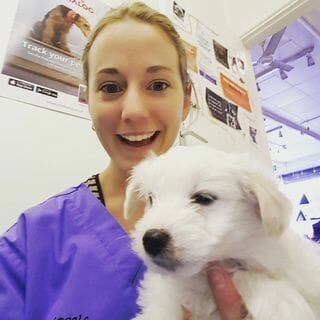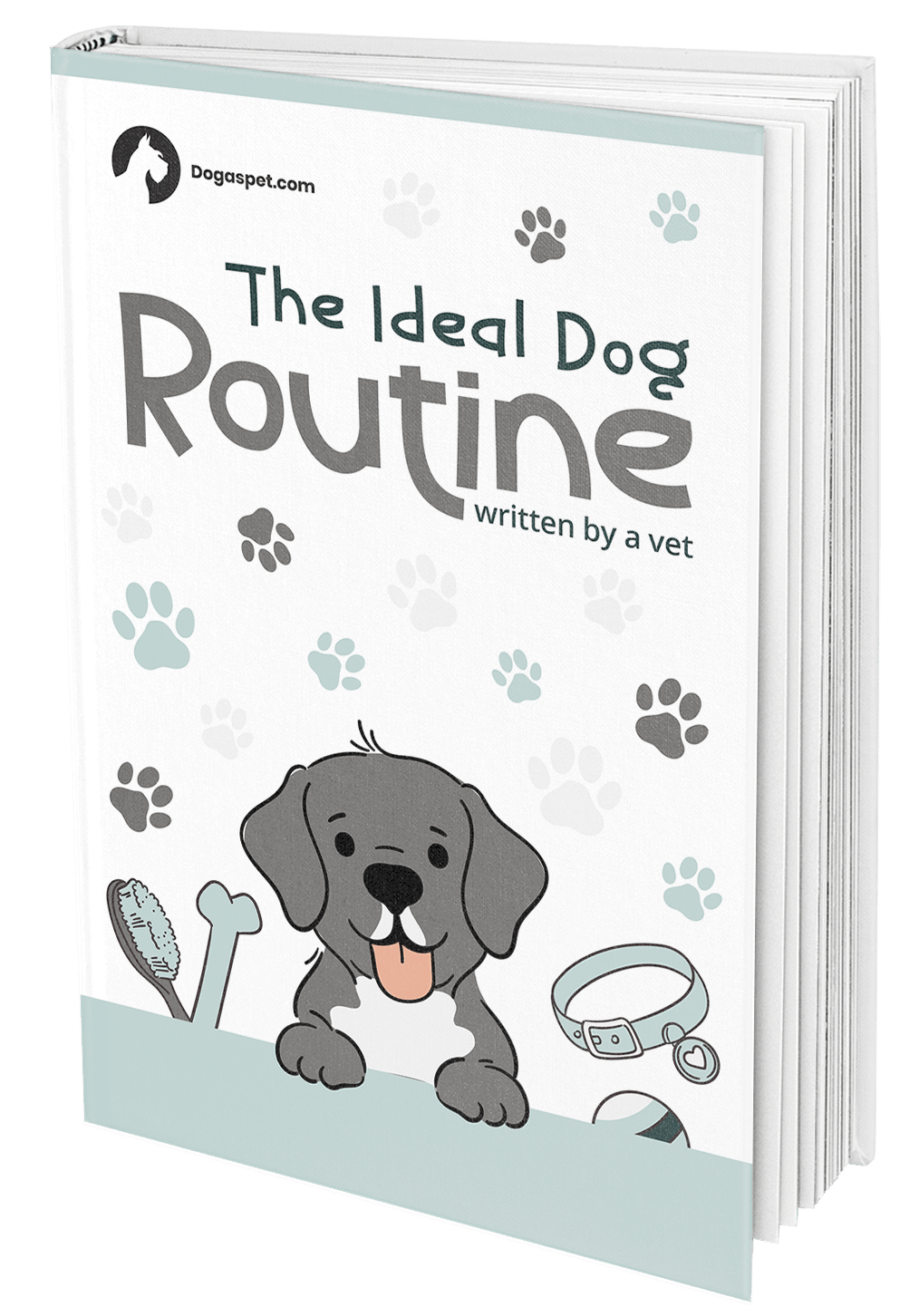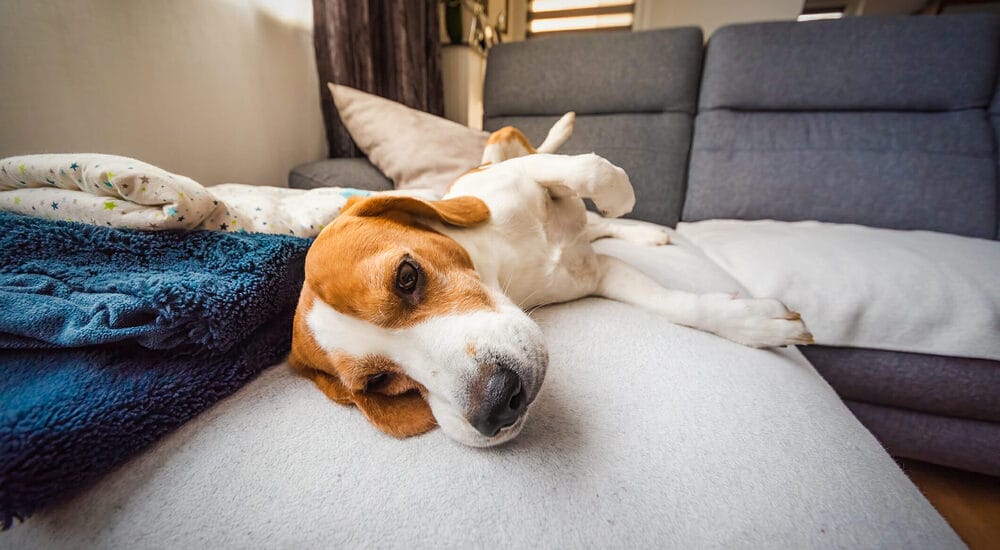
If you’ve noticed your dog expressing their anal glands on the couch or if your dog expresses their glands in the bed, you are not alone! This is a common, if stinky, issue. You may have smelled that characteristic ‘fishy’ odour, or perhaps you’ve noticed a brown or yellow stain.
As a dog can expresses anal glands when relaxed, we do sometimes find these stains and residues after a dog has gotten up from a sleep or nap. However, it is more common for a dog to express their glands when passing stool or while they drag or scoot their bottom along the ground.
Table of contents
What are dog anal glands?
Many people are unfamiliar with anal glands as they are not something humans have. For this reason, they can cause quite a bit of confusion.
A dog has two anal glands, one on either side of their anus. They are located between the internal and external sphincter so are not visible on the outside. However, if you look very closely, you may just see some pinpoint ‘dots’ where the fluid is expressed from.
If you were to pretend the anus was a clock face, and you look from the dog’s tail to their head, the glands are located at roughly 10 o’clock and 2 o’clock. They are a cm or two within the anus and resemble smooth grapes when full. If empty, they are not easily felt.
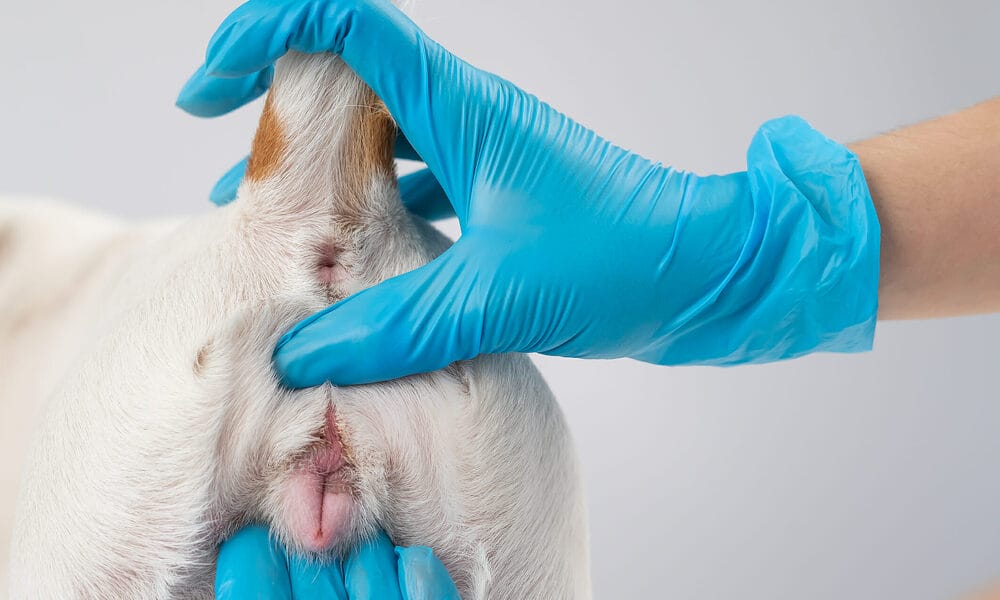
Can a dog express their own glands?
Absolutely, a dog can and should be expressing their own glands. This is something that should naturally happen every time a dog passes stool. The firm stool exerts pressure onto the gland as it passes through the anal canal, resulting in some fluid being expressed.
For most dogs, emptying their anal glands never causes issues. For others, they are not able to empty their own glands and this can cause some serious problems down the line. Dogs can start having trouble with their glands from any age.
What causes anal gland disease?
Those who are small and those who are over-weight are most prone to anal gland issues as the shape of these dogs’ bodies makes it harder for them to express their own anal glands. Certain breeds will be over-represented, including the Pug and Frenchie.
We know that those with atopic dermatitis and allergies are more likely to suffer with both ear infections and anal gland disease. So, it is sensible for a vet to check the anal glands if a dog is presenting with skin and ear issues.
Finally, dogs who are fed an inappropriate diet and who lack fibre are more likely to suffer with anal gland disease. In my experience, this is often the case when an owner feeds a home cooked diet that isn’t balanced. To avoid this, always consult a canine nutritionist before considering a home-made diet.
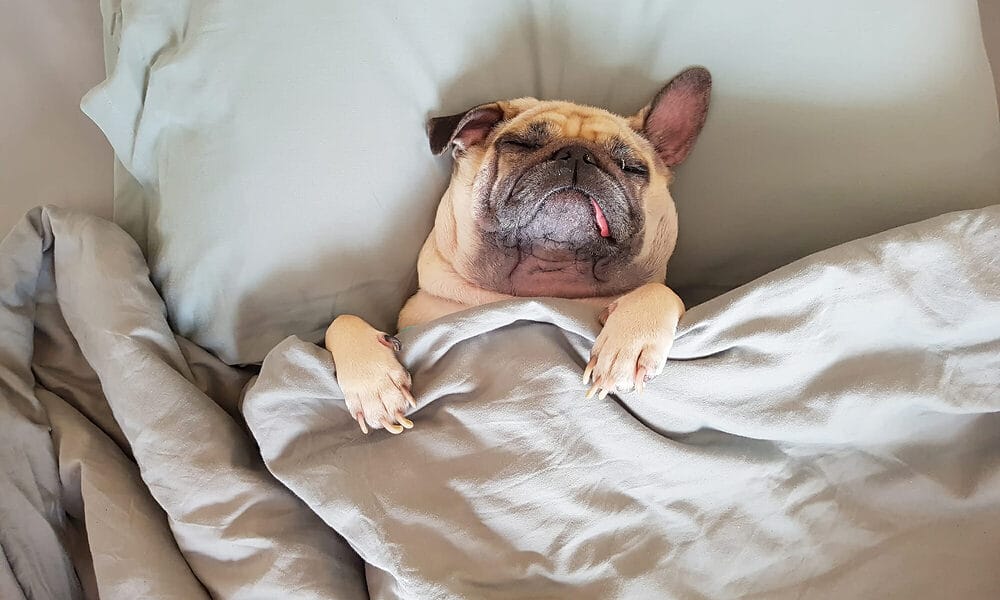
How to know if your dog needs their glands expressed
An owner whose dog has anal gland problems will find that they are always on the lookout for the “tell-tale signs”. These can include:
Bum dragging
The characteristic sign of a dog who has full glands is the “bum scoot” or “bum drag”. These dogs put their bum close to the ground, shift their back legs into the air and pull themselves using their front limbs.
This sort of movement is often mistaken as a sign of worms. However, in my experience, it is usually the glands that are the issue. We can also see bum scooting when a dog has an itchy anus due to e.g. food allergies.
Quickly looking behind towards the tail
One moment your dog is snoozing or eating a chew, the next they’re darting their eye back towards their bottom, as if they’ve been stung by a bee! This is a sign of discomfort somewhere in the back end and can be due to anal gland issues, flea allergies or muscle strains.
A fishy smell coming from the anus
If you’ve smelled the pungent aroma of anal glands, it is a smell that is hard to forget. It is different from the smell of poo and does have more of a “tang” or fishy scent.
If a female dog has a discharge from their vagina and there is a foul smell, this would be more likely to be a pyometra (uterus infection). So, if the owner of an unspayed bitch smells something abnormal coming from the back end, they should always check the vulva for any discharge.
Visible discharge around the home
If your dog is expressing their glands while resting or sleeping, this is generally because they are overly full and impacted. We might actually see this discharge on the dog’s bed or on the sofa or carpet.
The fluid has a varied appearance and can be a range of colours including dark green, yellow and brown. For some dogs, they express a thick paste, while others have a watery discharge.
Every dog has their own unique smell which they use to communicate with other dogs in the wild. To the untrained human nose, all discharge smells terrible!
Swelling or redness near the anus
Though not somewhere we tend to pay much attention to, it can be a good idea to get yourself familiar with what your dog’s anus looks like when it is healthy. If you find there is swelling around the anus or that the skin is red or puffy, this could be a sign of an anal gland problem.
Other considerations when we see swelling here would be a perineal hernia or a tumour. So, swelling in this area should always be discussed with a vet promptly.
Ruptured skin and pus draining
In some instances, owners may not know there is anything wrong with their dog’s anal glands until an abscess has formed. An anal gland abscess will form when there is too much liquid within the gland, and the skin ruptures due to the pressure.
We can see a hole in the skin which will be draining pus and can bleed quite a bit. A dog generally has the urge to lick this area a lot. Owners who are unfamiliar with anal gland abscesses can panic, wondering if their dog has been bitten or attached.
Should I be expressing my dog’s anal glands?
As a vet, many owners will come to me wondering if they should be expressing their dog’s glands, as they’ve heard of a friend who does it for their dog. It is very important to emphasize that not every dog will need their glands expressed and doing so unnecessarily can even do more harm than good.
We should only consider expressing our dogs’ glands only if they are showing signs of anal sac disease or if they have a history of chronic issues and we’re trying to prevent further impactions.
How to express dog anal glands?
Learning how to express your dog’s anal glands from the comfort of your home is a great skill to have. This way, you can stay on top of any issues; emptying the glands the moment they become impacted, rather than waiting for a free appointment at the vets. Of course, it is also a great money saver, with the price of emptying anal glands ranging from about $10-25 each time.
Many dogs appreciate having their glands expressed in a familiar setting by someone they know. A journey by car and a trip to the vet is usually the last thing a dog wants when their bum is uncomfortable.
Steps to follow for anal gland expression
- Pop on some latex gloves and lubricate the thumb and index finger with some Vaseline or KY Jelly. This makes the procedure easier for you and more comfortable for your dog, especially if they are a smaller breed.
- To express the left anal gland: Gently insert your index finger of your right hand into the anus, keeping the thumb on the outside of the anal canal. You should feel a smooth “grape” or “marble” that rolls around. Hold it firm and apply pressure, noticing that liquid comes out as you squeeze. Hold a tissue in place, to collect this liquid. Continue to squeeze until no more liquid can be expressed.
- To express the right anal gland: Repeat the same process but place your thumb inside the anus and keep the index finger on the outside.
- Wash the fur with warm, soapy water if needed.
- Always reward your dog with lots of praise and treats, so they associate their glands being expressed with good feelings.
It is important to say that some dogs really dislike their glands being expressed, especially if they’ve had negative experiences or have an anal gland infection or abscess, and are in pain.
If you need to bring your dog to the vet to have their glands expressed, there is nothing at all wrong with this.
Tips that help with the anal gland expression
- Ensure you’re feeling calm and your dog is in a relaxed mood. As expressing anal glands can be a little uncomfortable for your pooch, we want to try and make the experience as stress-free as possible.
- To avoid mess, consider expressing the glands outside or in a bathtub or shower. I personally am a fan of using the bath and a non-slip mat, as it is somewhere your dog will generally stay still, and the clean-up after is very simple.
- Where possible, have someone else there to help you restrain the dog. This person can also be “chief treat giver”, providing your dog with some high-value treats (like hot dog and chicken) to keep them on side.
- Some dogs will need a muzzle if there is a possibility they will snap.
Why is my dog still leaking after having their glands expressed?
Sometimes, the day of the anal gland expression, we might find the dog leaks a little from their glands. This is because they may be a little inflamed, and also because there could have been some discharge not washed away from their back end.
However, this should not last long and any ongoing leak is something that must be mentioned to the vet. It could be a sign of a more significant issue, such as an anal gland infection.
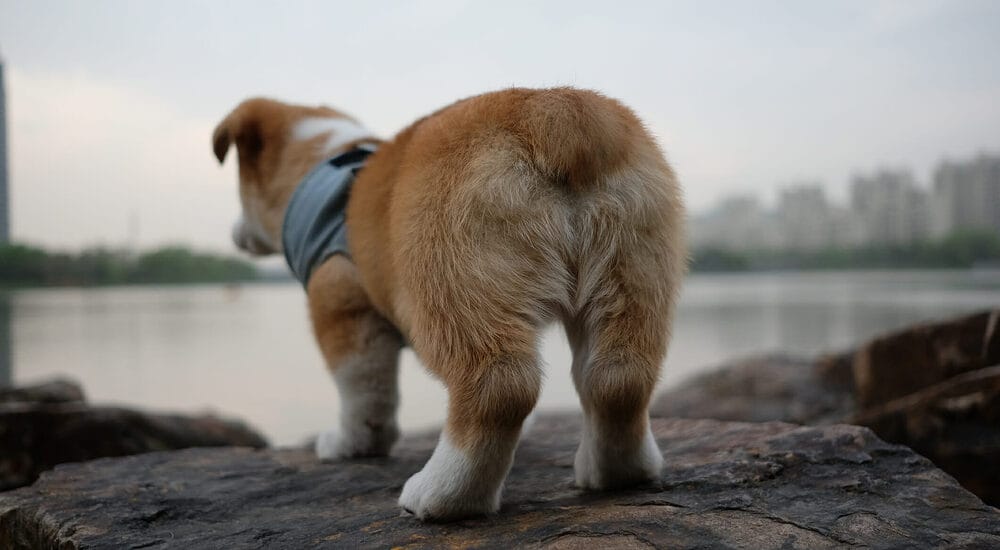
How is an anal gland abscess treated?
If your dog does develop an abscess, this is not something you can treat from home. These infections cause intense pain and the dog should be seen urgently. In some cases, the patient needs to be sedated in order to properly flush the gland.
The vet will issue antibiotics and anti inflammatories, as well as pain relief. Most vets use steroids instead of NSAIDs as they help to reduce the inflammation faster. A typical course of medicine will last about 5 days or so.
If a dog is trying to lick at their bottom, the vet will suggest a buster collar is used, to prevent this behaviour. You can keep your pooch occupied with things like food puzzles, chews and interactive toys.
If the dog tolerates it, the abscesses skin can be cleaned regularly with cotton wool and warm, salt water.
How to support your dog’s anal glands?
Did you know, it is often possible to prevent anal gland issues, as long as we follow the correct steps? sMany owners assume that nothing can be done to prevent blocked anal glands and that they are just “one of those things” but this is far from the truth.
Let’s take a look at some of the useful things we can do to help support our dog’s anal glands:
Let your dog poop!
One of the best things that you can do is to ensure your dog is passing a firm bowel movement at least once a day. Doing so, they naturally express their own glands, ensuring they never over fill. If your dog has ongoing issues with diarrhoea or constipation, consult a vet to see why this is and what can be done
Provide the right supplements
There are supplements available that can help to prevent anal gland impaction and will contain lots of fiber to contribute to gut health. Some examples include Protexin Profibre and Glandex. Probiotics may also be worth trialing.
Keep your dog in shape
Keeping your dog lean and slim is also critical, as any excess fat in the area can make it hard for the glands to empty themselves. We should be aiming for a Body Condition Score of 3.5 to 4.5 out of 9.
Look for signs of filling glands
We should always be on the lookout for signs of glands filling up; like bum scooting or a fishy smell. At the first sign of problems, express the glands. The sooner this is done, the less risk of an impaction or abscess.
FAQ – Frequently Asked Questions
You may have a few questions before we wrap things up; here are some of the most frequently asked:
How can I get rid of dog gland smell on furniture?
Now for one of the most important questions! If your dog does manage to dirty your furniture, rug or carpet, what can be done? This is such a pungent aroma that many struggle to eliminate it with regular cleaning.
As well as washing the offending area with soap and hot water, you should use an enzymatic cleaner. This helps to break down the molecules and eliminates the odour rather than just masking it.
I’ve heard of a surgery for anal glands; is this an option for my dog?
For dogs who suffer with chronic and ongoing anal gland issues, having the glands removed is an option. This is called an anal sacculectomy. It is a specialised procedure that can cost several thousand dollars and may need to be done in a referral hospital.
Surgical complications can include stricture formation and even faecal incontinence. However, for those dogs whose anal glands are making their lives a misery, this may be a surgery worth considering.
My German Shepherd has recently started to have issues with his back end, could this be his glands?
Importantly, not every “back end” issue will be due to anal gland disease. When a German Shepherd is affected, we need to consider a condition called Anal Furunculosis. This is a disease that is mostly only seen in the German Shepherd and its crosses.
Signs can start off subtly but can quickly escalate and most dogs become very painful as the disease progresses. They may cry when passing stool and can develop visible tracts around the anus. It is thought that this is an immune mediated disease.
Treatment of anal furunculosis usually consists of a hypoallergenic diet, immune suppressants and excellent backend hygiene. In severe cases, surgery and cryotherapy are to be considered.
Conclusion – Avoiding abscesses
There is no doubt that the anal glands can cause real issues for some dogs. While chronic blockages are frustrating to deal with, we do need to stay on top of things to avoid abscesses from forming.
There is plenty we can be doing to prevent anal sac disease, and any issues should be dealt with promptly to prevent them from getting worse.
